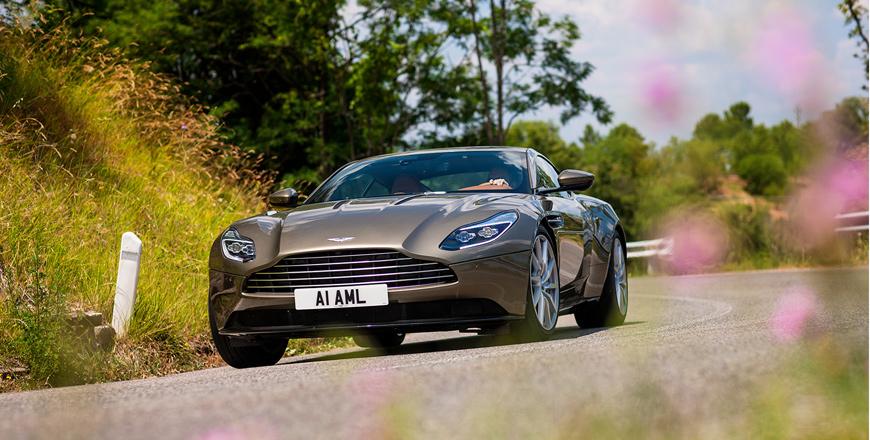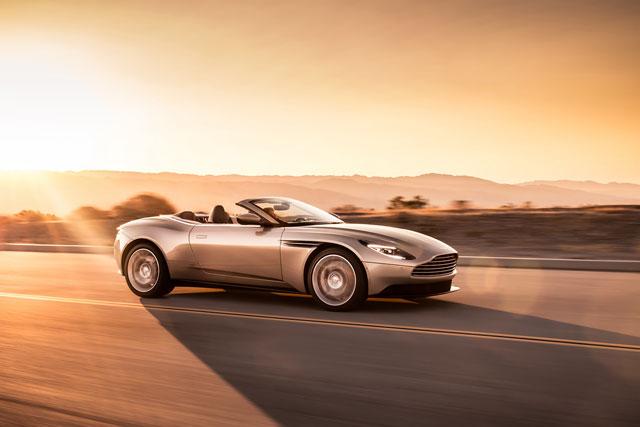You are here
Aston Martin DBS Superleggera: Beauty and beast singularly personified
By Ghaith Madadha - Oct 14,2019 - Last updated at Oct 14,2019

Photo courtesy of Aston Martin
A phenomenally powerful car with devastating good looks and on the mark dynamic abilities, the Aston Martin DBS Superleggera not only lives up brand enthusiasts’ expectations, but surpasses them and is the car to make a convert of the uninitiated.
Resurrecting the British brand’s iconic DBS nameplate the Superleggera’s layout, luxury and comfort are rooted in the “grand touring” segment, but it is honed and fettled to the level of a supercar. Based on the DB11 AMR grand tourer as a starting point, the DBS Superleggera is both reassuringly familiar, yet refreshingly different in its focused disposition and ferocious firepower.
Seductively predatory
Sharing the same roofline, waistline, Coke-bottle hips and proportions with the DB11 grand tourer, yet taking some styling cues and inspiration from the track-only limited production Aston Martin Vulcan’s predatory stance, the DBS Superleggera strikes a seductive note between elegance and aggression. Without resorting to overstated styling elements, the Superleggera oozes a sense of muscular urgency and sensual tension in it demeanour. Incorporating lower and sharper air dam and side sills, and adding a discrete rear spoiler, the Superleggera, however, even simplifies certain design elements to create a more viscerally-charged and less complex sense of appeal than the DB11.
Possibly the most beautiful modern-era Aston yet, the DBS Superleggera’s more visceral front design is dominated by a wide, full height grille with a honeycomb mesh replacing the DB-11’s horizontal slats. Snouty and hungry, the DBS’ grille is flanked by bigger, deeper side intakes and more rounded better looking headlights.
It also features bigger bonnet extraction vents, restyled side vents and less jutting rear fascia, while slim, dramatically squinting and uncomplicated rear lights replace the DB11’s C-shaped design. The DBS also incorporates quad rear exhaust tips and a double rear air diffuser that generates 180kg downforce at its 340km/h top speed.
Epic ability
Top of the food chain among Aston’s regular model line-up, the DBS Superleggera is powered by more amply tuned version of the DB11’s 5.2-litre twin-turbocharged V12 engine, which is mounted as low and far back under the bonnet to achieve a low centre of gravity and ideal within wheelbase weight distribution. Gaining as much as 85BHP and 147lb/ft over it DB11 relation the DBS cranks out an epic 715BHP at 6,500rom and 663lb/ft torque throughout an overarching 1,800-5,000rpm mid-range. And with a 72kg weight loss owing to its lightweight carbon-fibre body panels, the DBS’ performance is as devastating as its looks.
Demolishing the 0-100km/h benchmark in 3.4-seconds and the 0-161km/h dash in 6.4-seconds, the DBS also gains a shorter, more aggressive 2.93:1 final drive ratio for more explosive responsiveness. With warp speed-like on the move versatility, it can accelerate through 80-120km/h in just 2-seconds and onto 161km/h 2.2-seconds later, in fourth gear. Progressively urgent in unleashing it epic power potential and underwritten by an indefatigable reservoir of torque, the DBS is vicious in delivery yet silky smooth in operation, and even feel somewhat like a naturally-aspirated car in how swift its twin-turbos spool up and how seamlessly output builds to full boost.
Fast and focused
With a reworked exhaust system lending a more vocal and harmonic edge to its magnificent V12 engine, the DBS’s acoustics encompass a broad range from bass-heavy idle to a screaming, thundering and urgent climb to redline, and becomes more prominent in Sport+ driving mode. Meanwhile, its rear transaxle 8-speed automatic gearbox balances the engine for to achieve ideal weight distribution and shifts in a silky smooth and responsive manner. It too can be set to more immediate, succinct and aggressive shift patterns through the driving mode selector, whether driven automatically or through the fixed steering column-mounted manual mode paddle shifters.
Instantly reminiscent of the DB11 in how it drives with which it shares its front double wishbone and rear multilink suspension configuration, it, however, soon becomes apparent that the DBS is so much more focused. Settled and reassuringly planted on the road at speed, the DBS is undoubtedly a continent-shrinking and comfortable grand tourer. Driven through corners the DBS’ steering feels direct, precise, quick and meaty, without being fidgety. Pouncing into corners with immediacy and superbly taut body control, the DBS is nimble, balanced, and delivers intuitively exacting reactions and movements, yet is surprisingly resilient to either under- or over-steer.
Confidence and comfort
Taut, focused and agile with precise reflexes, the DBS also draws upon huge reserves of grip to deliver a level of road-holding commitment and confidence above and beyond some similar cars. Inspiring, reassuring and connected to drive, the DBS’s stability and traction systems seem to work with an effective yet unobstructive manner, while brake-based torque vectoring and a limited-slip rear differential enhance its agility and ability to manage it enormous power. Meanwhile ride quality is settled and buttoned down but smooth and supple enough in default driving mode, but can be made stiffer and more focused in Sport and Sport+ modes if desired.
Refined inside and luxuriously finished with high-end quilted leathers, woods, metals and Alcantara, the DBS’ is sumptuously and extravagantly welcoming. Well accommodating, supportive and comfortable in front, it is very much a driver’s car but with occasional use rear seats and a boot that accommodates weekend luggage for two, it practical as supercar go. Shrinking around the driver and easy to place through corners, the DBS also offers good front visibility, and blind spot warning, rear and bird’s eye view cameras for additional visibility and confidence in confined spaces, and is well-equipped with standard driver assistance, safety, convenience and infotainment features.
TECHNICAL SPECIFICATIONS
Engine: 5.2-litre, twin-turbocharged V12-cylinders
Compression ratio: 9.3:1
Valve-train: 48-valve, DOHC
Gearbox: rear-mounted 8-speed automatic
Drive-line: Rear-wheel-drive, limited-slip differential
Final drive: 2.93:1
Power, BHP (PS) [kW]: 715 (725) [533] @6,500rpm
Specific power: 137.4BHP/litre
Power-to-weight: 422.3BHP/tonne
Torque, lb/ft (Nm): 663 (900) @1,800-5,000rpm
Specific torque: 172.9Nm/litre
Torque-to-weight: 531.6Nm/tonne
0-100km/h: 3.4-seconds
0-161km/h: 6.4-seconds
80-120km//h: 2-seconds (4th gear)
80-161km/h: 4.2-seconds (4th gear)
Top speed: 340km/h
Fuel consumption, combined: 12.28-litres/100km
CO2 emissions, combined: 285g/km
Length: 4,712mm
Width: 1,968mm
Height: 1,280mm
Wheelbase: 2,805mm
Track, F/R: 1,665/1,645mm
Weight distribution, F/R: 51 per cent/49 per cent
Steering: Electric-assisted rack & pinion
Steering ratio: 13.09:1
Lock-to-lock: 2.4-turns
Suspension: Double wishbones/multilink, adaptive dampers
Brakes, F/R: Ventilated ceramic discs 410mm/360mm
Brake callipers, F/R: 6-/4-piston callipers
Tyres, F/R: 265/35ZR21/305/30ZR21
Related Articles
Launched in 2019 as the ragtop variant of the Aston Martin DBS Superleggera, the Volante — or convertible in Aston-speak — beautifully inter
A slinky low-slung and wide grand touring 2+2 sports coupe, the Aston Martin DB11 V12 is a comfortable continent crunching personal luxury c
Not one partial to the adventures of Britain’s most iconic fictional gentleman spy, the opportunity to drive his car brand of choice was one

















